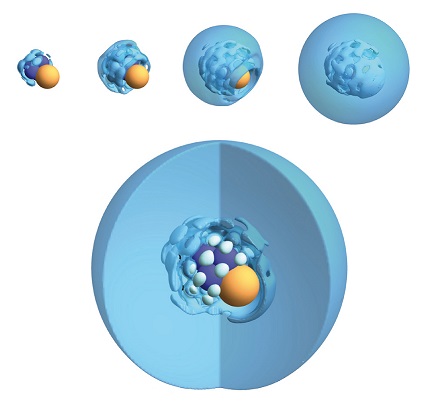Dynamical modeling of quantum clusters :
Examples of such studies are the nucleation of neon clusters and the photodissociation of nitric oxide (NO) in neon matrix. A new quantum dynamics method has been recently designed which is based on a multiconfiguration approach using Gaussian wave packets and which takes into account bosonic or fermionic particle exchange properties.
Helium nanodroplets are also the subject of recent studies. One is the density functional description of helium atoms (He-DFT) to interpret experimental results on Ca* solvation in the presence of argon atoms in a superfluid helium nanodroplet. Another example is the photodissociation of an alkali atom from the surface of a helium nanodroplet.

Simulation by He-DFT of the solvatation by increasingly larger helium nanodroplets (light blue) of a complex made of a calcium atom (yellow) and 4 argon atoms (dark blue).
Simulation performed by Hernando De Castro Alberto.
Condensed water structures :
This new topic has been initiated in order to study the influence of this ubiquitous solvent with outstanding properties on the photochemistry and photophysics of solvated molecules. The remarkable clathrate structure is studied in comparison with different ice structures and water in the photodissociation of dihalogen.
Dissipative quantum dynamics and control :
This field comprises several lines od research, in close connection with experiments. An atomistic model has been established to study the influence of protein fluctuations onto vibrational ladder climbing in carboxy- hemoglobin and this model has been combined with control theory. The results are very promising in view of future experiments aiming at a precise determination of protein–ligand interactions.
The theoretical models of dissipative quantum systems driven by strong laser pulses are at the heart of studies of the isomerisation reactions in solutions. These models have also been fruitfully applied to model strong-field picosecond-laser experiments and exciton generation in nanometric semiconductor structures. These technics might open the way towards optical manipulation of semiconductor quantum systems in almost decoherence free conditions.
Another line of research in the field of dissipative quantum dynamics is the physisorption and chemisorption of hydrogen on graphite and graphene. Such processes are important as possible precursors to the formation of molecular hydrogen from atoms on interstellar grains. They also play an important role in the formation of graphane, the hydrogenated form of graphene, which has different electronic properties. These processes are studied with wavepacket and reduced density matrix propagation methods.
Field effect electronic emission :
Field emission is a common process in high voltage devices which consists in electronic emission from metallic surfaces subjected to large electric fields. The work aims at understanding how the detailed structure of the surface influences its emission properties.
Quantum optics and Quantum information :
In this field, the different research lines and main results are :
![]() the study of the Pancharatnam phase for different q-bits (two-level atom, Cooper box, trapped-ions) interacting with photons and the demonstration of their extreme sensitivity to the radiation flux.
the study of the Pancharatnam phase for different q-bits (two-level atom, Cooper box, trapped-ions) interacting with photons and the demonstration of their extreme sensitivity to the radiation flux.
![]() the study of transient effects in a MAZER and the demonstration of opto-mechanical effects on optical adiabatic transitions
the study of transient effects in a MAZER and the demonstration of opto-mechanical effects on optical adiabatic transitions
![]() the study of temporal and spectral modifications of a one–photon wavepacket interacting with two
the study of temporal and spectral modifications of a one–photon wavepacket interacting with two
separated atoms in a waveguide and the determination of the effet of real and virtual photons on the atom and field dynamics
![]() the interaction of an arbitrary quantized –multimode- pulse with an atomic system. Development of a new theoretical method for the determination of the dynamics and of the transient effects.
the interaction of an arbitrary quantized –multimode- pulse with an atomic system. Development of a new theoretical method for the determination of the dynamics and of the transient effects.



















